Dec 30, 2025
Dec 30, 2025
Pilgrimage-I
Continued from Part LXXIV
Nearly all communities and religions in the world attach significance to places which have some connection with any worldly or supernatural act(s) or event(s) of the divine (God) or His messenger(s); the birth, enlightenment or death of founder and saints; sites of the spiritual calling or awakening; supposedly a dwelling or living place of any deity; or even the places associated with miracles. Many Memorable places linked with the incarnations of divine, the motivational occurrences and events of God and great human beings are also venerated as pilgrimage places. Such places and sites are so often memorialized or immortalized as shrines or temples and community people are encouraged to visit them for their material and spiritual benefits and well being. A journey involving visit of faithful people seeking moral or spiritual solace at these sites and places is called pilgrimage which in many cases also leads to personal transformation in a positive manner. Almost all communities and religions in the world have a system of pilgrimage in some or the other form but it has a special significance in Hinduism owing to its long history and complex socio-religious traditions.
Evolution and Significance of Pilgrimage
Pilgrimage in Hinduism is prevalent from the ancient times that involved voyage and visit to the sites or seats where any divine power, knowledge (Jnan), or spiritual experience was considered particularly accessible. According to some scholars, the earliest indication of pilgrimage is found in the Rig Veda in which the “wanderer” is glorified in certain verses. However, numerous later Hindu texts such as the Epic Mahabharata and many Puranas have references citing the significance of sacred religious sites and need for the Sanatana Dharmese (Hindus) to visit these places to receive boons and blessings of divine for the health, wealth, progeny, performance of rites associated with ancestors and deceased kin, and own salvation. Apart from the scriptural texts, several other literary books of devotional nature in Sanskrit other vernacular regional vernacular languages too have highlighted in many ways and several such places and their special healing or miraculous capacities.
In essence, the pilgrimage could be defined essentially as a journey undertaken by the faithful devotees to realize intended socio-religious objectives. The traditional nomenclature in Sanskrit and Hindi languages for the pilgrimage is “Tirtha Yatra”. Commensurate with the objectives, pilgrimage to the sacred places has been traditionally considered as a righteous duty in Hinduism to earn Phala (religious merit) during the life. Unlike the dogmatic religions like the Christianity and Islam where any questions or discussions on the efficacy of religious tenets are strictly prohibited, the sages and scholars in Hinduism always believed and encouraged free speech, debate and discourse in religious matters with due reasoning and discretion. This has led to multiple philosophies, sects and denominations, traditions and practices, deities, temples, places of pilgrimage, and so on, to coexist in harmony as part of Hinduism. Therefore, with a view to forge the cultural unity and integrity in diversity, Adi Shankaracharya is known to have popularized the concept of four dhams, a pilgrimage of the same was considered akin to pilgrimage of the whole of India.
Hindu scriptures visualize the material existence as “Maya” (elusion or charlatanry) that exists as a vicious web for the human beings and the latter’s goal should be come out of the clutches of this elusion. Sometimes the word “pilgrim” is also used as a metaphor for the mortal human beings and pilgrimage to the holy destinations as part of their spiritual journey. Hindu pilgrimage sites are so often found located at the places rich in natural beauty and harmonious environment, which is believed to be equally pleasant to the human beings and deities as well. The term “tirtha” in Sanskrit and Hindi itself carries special meaning and significance for holy places, which verbatim means a crossing place or ford, where one could easily cross the water not being deep. So it is not surprising that many Hindu tirthas are indeed located at the bank of rivers and the journey associated with it is called tirtha-yatra. Although pilgrimage was always undertaken by Hindus since ancient times, it has increasingly become more prevalent and popular with the quick and comfortable means of journey available in modern times via road, rail, air and water.
As already mentioned, the inherent features and freedom of devotion granted to the adherents have made the Hinduism very versatile yet complex during the course of history giving a lot of variety, scope and choice to devotees. Hindus scriptures believe in one Supreme Being as unmanifested God (i.e. Brahman or Ishwara) but also endorse worship of His manifest forms as deities associated with different cosmic functions. This has led to the concept of three principal deities (Triad) as Brahma, Vishnu and Shiva associated with three most important cosmic functions of creation, preservation and withdrawal (or destruction) respectively in Hinduism. In addition, many other deities (i.e. gods and goddesses) associated with various other functions are also visualized and worshipped by Hindus. Accordingly, several Sects and Denominations have evolved in Hinduism which are commonly known as Sampradaya. Of these four major Sampradaya are Vaishnavism, Shaivism, Shaktism and Smartism.
Vaishnavism is the most popular and widespread Sampradaya (sect) among Hindus; the followers are called Vaishnavas who have a tradition of worshipping God as Vishnu. Vaishnavas are divided into several smaller sub-sects, who worship one or other avatar (manifestation) of Vishnu who is believed to have Dashavtara (ten incarnations). Shaivism is the second largest and widespread sect among the Hindus and its adherents worship God under the name of Shiva. Shaivism too have many traditions and the devotees worship him both in the form of ‘Lingam’ and/or His human form with consort Parvati. The third major Sampradaya is Shaktism which is based on the devotion of the Goddess Shakti or Durga. Adherents of this sect consider Shakti as the Supreme Deity and many people worship her as the consort of Shiva. In Shakti Sect, people worship Shakti in various forms such as Durga (more common and popular), Kali, Devi, Parvati, and so on. The fourth and mainstream Hindu Sampradaya is Smartism: The Smartas are not one deity centric; instead, they believe in universality of Hinduism and pay obeisance to many deities with focus on five major ones, namely Vishnu, Shiva, Shakti, Ganesh and Surya.
The aforesaid Sampradaya or sects are further divided in several sub-sects and traditions. For instance, among the Vaishnavas themselves, more prominent sub-sects are Ramanandi Sampradaya, Gaudiya Sampradaya, Udhava Sampradaya and Swaminarayan Sampradaya and many other lesser known traditions such as Manavala Mamunigal Sampradaya, Vaikhanasa Sampradaya, Ekasaranism, Thenacharya Sampradaya, Krishna Pranami Sampradaya, Mahanama Sampradaya and Varkari Sampradaya. Some other important sects include Ganapatism (worship of Ganesha as the supreme deity), Suryaism (Believers of Vedic rituals), Kaumaram (worship Murugan Karttikeya, etc. Although Hanuman worship is not identified as a separate sect but a large number of Hindu devotees worship him as a major deity in large parts of the Indian sub-continent and Hindus worldwide. Owing to the aforesaid reasons, a large number of temples, shrines and sacred religious places have come up since ancient times, many of them at the banks of rivers offering ideal conditions of pilgrimage.
In the case of Hindu civilization, majority of the places of pilgrimage are linked with the legendary events of the lives of gods or holy men. Although any site or place could be a focal point for the pilgrimage owing to some religious and cultural reason but usually sacred cities, rivers, lakes and mountains offer ideal conditions for such purpose. For instance, the cities of Ayodhya, Mathura, Varanasi, Ujjain, etc. are considered as holy cities since ancient ages; the first two as the birth sites and Karmabhumi of Sri Ramchandra and Shree Krishna (both believed to be incarnations of god Vishnu) respectively while the latter two cities are associated with certain life events of god Shiva. Similarly, the Kumbh Mela is considered a major pilgrimage and festival site in Hinduism which is celebrated in a cycle of about twelve years coterminous with the revolution of Brihaspati (Jupiter) at four river-banks sites of Allahabad (a confluence of Ganga-Yamuna-Saraswati Rivers), Haridwar (Ganga River), Nashik (Godavari River) and Ujjain (Shipra River). These occasions are marked with a ritual dip by the devotees in the river along with a range of activities such as mass gatherings of saints, religious discourses, and events of fairs, education and entertainment. The mass bathing in these rivers signifies Prayaschitta (atonement) for the past mistakes and a means of cleansing of the sins committed.
Popular Pilgrimage Events/Sites
As already mentioned earlier, the list of the sites, places and events of pilgrimage in Hinduism is too long; hence the author has endeavoured to briefly list out some of the more important ones out here:
Kumbh Mela: As already mentioned in the previous paragraph, the Kumbh Mela held at the holy river-banks of the sacred cities of Prayagraj, Haridwar, Ujjain, and Nashik could simply be illustrated as among the largest human gatherings points in the world for any religious cause. The annual Magh Mela at these places are held every year besides the periodic larger assemblage of devotees after every six (ardh-Kumbha) and twelve (Kumbha) years for holy dip and associated rituals as mandated in ancient Hindu texts and inscriptions. Of these, the Kumbha Mela at Prayag and Haridwar are considered as most auspicious for which even respective governments are involved on a large scale to ensure safe and successful pilgrimage of the devotees. Similar periodic Magh Melas or Makar Melas are also prevalent in other parts of the country, including the southernmost state Tamil Nadu, that include sacred bathing, rath yatras and other festivities.
Char Dham: These are four sacred pilgrimage sites at the holy towns/cities of Badrinath, Puri, Dwarka and Rameswaram. In an alternate narrative, the Himalayan towns of Badrinath, Kedarnath, Gangotri and Yamunotri are also considered by Hindus akin to Char Dham (four abodes), and are often referred to as Chota Char Dham in the northern India. According to an age old belief, every Hindu shall visit Char Dham during his (or her) lifetime. Of these, the main temple at Badrinath, Dwarka and Puri are dedicated to god Vishnu while the one at Rameswaram belongs to god Shiva. Adi Shankara is believed to have popularized these holy sites as Char Dham and another interesting feature of about them is that these dhamas are also linked with four Hindu epochs: Badrinath (Uttarakhand) with Satyuga; Rameswaram (Tamil Nadu) with Tretayuga; Dwarka (Gujarat) with Dwaparyuga; and Jagannatha Puri (Odisha) with Kaliyuga.
Kanwar Pilgrimage: This is yet another event of mass event and participation of devotees for the annual ritual of religious pilgrimage for gathering holy water from the River Ganga at places like Haridwar, Gangotri, Gaumukh, etc. to carry it across hundreds of Kilometre distant places for dispensing it as offering in various Shiva temples.
Major Temple Cities: Among the numerous temple cities, some of the major holy cities for pilgrimage are Ayodhya (Uttar Pradesh) for Ram Janmbhumi and associated annual long (Chaudah Koshi) and short (Panch Koshi) circumambulations; Jagannath Temple at Puri (Odisha) for god Vishnu (His 8th incarnation Shree Krishna) and annual Rath Yatra celebration; Katra (Jammu & Kashmir) for Vaishno Devi Temple; Tirumala – Tirupati (Andhra Pradesh) as abode of Tirumala Venkateswara (Vishnu) Temple; Sabarimala (Kerala) of Swami Ayyappan; Temple at Shirdi (Maharashtra) dedicated to Sai Baba of Shirdi; and other important temples dedicated to Shiva include Kashi-Vishwanath temple at Varanasi (Uttar Pradesh), Somnath Temple at Prabhas Patan - Veraval (Gujarat), Brihadeshwara Temple at Thanjavur (Tamil Nadu), Mahakaleshwar Temple at Ujjain (Madhya Pradesh), and do on.
Shakti Pithas: The Shakti Pitha are important temples and pilgrimage destinations in Shaktism Sampradaya, which is Goddess-centric in Hinduism. These shrines are dedicated to various manifestations Adi Shakti or Mother Goddess popularly known as Shakti, Durga, Devi, Kali, Parvati, etc. Although in Puranas such as Srimad Devi Bhagavatam, a varying number of Shakti Pithas are mentioned but as per common knowledgs there are fifty-one Shakti-pithas, of which eighteen are considered as major Pithas (Astadasha Maha), of which the two principal pithas are located at Kalighat (Kolkata, West Bengal)) and Kamakhya (Gauhati, Assam).
Holy cities: Some of the Indian cities find a mention in the Mahapuranas and Epics Ramayana and Mahabharata as the birthplace and/or Karmabhumi (working place) of the legendary and/or mythical personalities (gods & goddesses, great men like kings & sages, etc.), and such cities are now acknowledged as pilgrimage sites in the modern age. Some of these important cities are Varanasi (ancient Kashi) believed to be established by god Shiva, Prayagraj as confluence of holy rivers Ganga, Yamuna and Saraswati, Haridwar & Rishikesh for god Vishnu, Mathura-Vrindavan as birthplace and early Karmabhumi of Shree Krishna, Dwarka established by Shree Krishna, Ayodhya as birthplace and kingdom of Sri Ramchandra, Kanchipuram for goddess Parvati; named a few, the actual list of holy cities is rather long.
Jyotirlingams: Also known as Jyotirling or Jyotirlinga, according to Shiva Purana there are sixty-four original Jyotirlingam shrines, of which twelve known as Kedarnath, Mahakaleshwar, Somnath, Vishwanath, Rameshwaram, Mallikarjun, Omkareshwar, Bhimashankar, Trimbakeshwar, Nageshwar, Baidyanath and Grishneshwar are called the Maha Jyotirlingam (The Great Jyotirlinga). These temples are located in various states of India and are considered most auspicious sites of pilgrimage.
Murugan Kartikeya Pilgrimage: Since ancient times, god Murugan is predominantly worshipped as major deity in the state of Tamil Nadu and parts of South India, Sri Lanka, and some Southeast Asian countries. He was elder son of Shiva and is known as Kartikeya or Skand in the northern India. Many temples and routes associated with him are holy pilgrimage sites of Hindus in these parts.
Pancha Ishwarams: These are five ancient temples dedicated to Ishwar (God) as Shiva in the coastal regions of Sri Lanka, namely Naguleswaram, Koneswaram, Ketheeswaram, Munneswaram and Tondeswaram, which are popular as important pilgrimage shrines, particularly for Tamil people.
Many of the aforementioned cities such as Varanasi, Ayodhya, Mathura, Haridwar, Ujjain, Dwarka, Puri, Tirumala, Srirangam, Kanchipuram, etc. find a mention in the ancient Puranas, or even Vedas, in the same or some other name, and are considered among the holiest pilgrim sites of Hindus. The Shaivas in Tamil Nadu and other parts of South India consider Chidambaram as the heart of the world and the temple of temples. Similarly, the Vaishnavas treat Sri Rangam as the most holy place and refer to it as Vaikuntha on earth. The Garbhagriha in various temple complexes is considered as the most auspicious area where the idol(s) of the chief deity is located. Perhaps even many Hindus would not be aware that there is a scientific basis for the construction of Hindu temples and Garbhagriha in it as also the installation of the idols. The Agama Shastras are ancient Hindu texts containing such methodology and details; the installation of idol of the deity itself has an elaborate procedure of the Pran-Pratishtha (infusion of life energy) into it before worship is undertaken by devotees. In the following section and Part II, the author proposes to briefly explain important shrines and their pilgrimage value.
Char Dham Pilgrimage
Of the three principal manifested deities in Hinduism, neither there is much following nor many temples and pilgrimage sites are found in the name of the creator god Brahma. The majority of pilgrimage places in India and abroad are dedicated to Vaishvanism and Shaivanism with the principal deities Vishnu and Shiva, and their manifested forms; and Shakti Pithas are specifically dedicated to goddess Shakti or Devi. Notwithstanding this arrangement, the most of Hindus have no qualms about the specific deity and love to visit all sacred places without any qualification or reservation. It is widely believed that the scholar and sage Adi Shankaracharya had introduced the concept of Char Dham in Hinduism by simultaneously establishing four Shankaracharya Peetha (seats) too, one at each dham, by creating Mathas (institution / monasteries) with headquarters at Badrikashrama (Jyotirmatha Pitham) in the north, Sringeri (Sringeri-Sharda Pitham) in the south, Dwarka (Dwarka Pitham) in the west and Jagannath Puri (Govardhan Pitham) in the east.
According to a popular belief, Nara-Narayana (amsa-avatar of Vishnu) had Tapasya (penanace) at Badrinath, Uttarakhand in the ancient age (Satyuga). The place was densely populated with berry trees around that time and hence was known as Badrika-Vana. The place was so renamed as Badrinath, i.e. the Lord of Berry forest and reckoned as the first Dham. The second dham Rameswaram, Tamil Nadu shot into prominence in Tretayuga when Prince Ram (believed to be an incarnation of Vishnu) made a Shivalingam here and worshipped it to receive blessings of god Shiva in the ensuing Ram-Ravan war. Dwarka, Gujarat had been chosen as the third auspicious dham because of its glory during the Dwaparyuga after Shree Krishna (yet another incarnation of Vishnu) had chosen to shift the seat of his kingdom from Mathura owing to constant threat posed to his kin and people by the Magadha King Jarasandha. The fourth dham is at Puri (Odisha) where Vishnu is worshipped as Jagannath in the current epoch of Kaliyuga.
1. Badrinath Dham
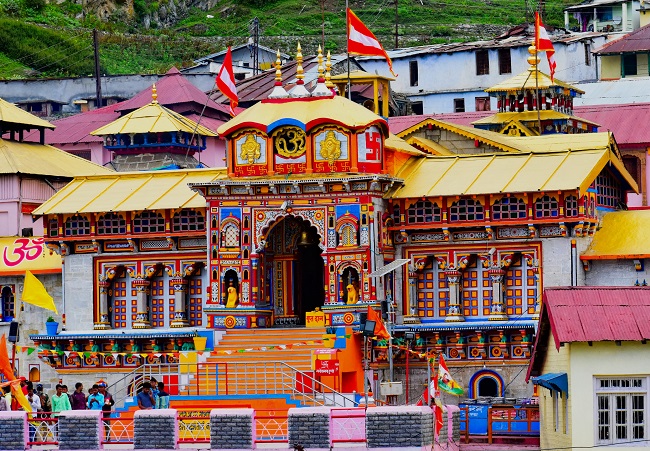
Badrinath Dham is located between the Nar and Narayana mountain ranges in the Garhwal hills on the banks of the Alaknanda River in the northern state of Uttarakhand. Nearest Nilkantha peak has a height of about 6,560 meters and other nearby places of interest are the beautiful sightseeing locations such as Vyas Gufa, Mana, Maatamoorti, Charanpaduka, Bhimkund, etc. The winter seat of Badrinath Dham is Joshimath, which is situated on the slopes near the confluence of the holy Alaknanda and Dhauliganga rivers. Unlike the other three dhams, the Badrinath Dham remains open for the pilgrims only from April to October during the year. Here the Badrinath temple is the most auspicious as well as the main shrine of interest of the pilgrims. According to a legend, Adi Shankara had discovered the idol of Badrinarayan comprised of black Shaligram stone and he originally enshrined it in a cave in vicinity of the Tapt Kund hot springs. Later the King of Garhwal moved the idol to the present temple in the 16th century, which is about fifty feet tall covered with a gold gilt roof. The temple façade is built of stone with arched windows and a stairway leading to a rather tall arched gateway as its chief entrance.
One would find a large pillared hall, mandapa, leading to the garbhagriha with the idol of Badrinarayana. In Hindu scriptures, the place finds a mention as Badari or Badarikaashram, a seat of Vishnu in the form of Nar-Narayana. The Bhagavata Parana carries an elaborated description of Vishnu as the sages Nara and Narayana who had been undergoing penance for time immemorial for the welfare of all the living beings. Several legendary stories are associated with the place and in one such tale, Vishnu’s spouse Lakshmi is said to have turned herself into a huge Badari (Badri Vishal) sheltering him from the scorching heat and light of sun, a reason why Vishnu is called Badrinath too. The mountainous areas surrounding the Badrinath Dham is also considered auspicious and finds a mention in the great Epic Mahabharata in the Swargarohana Parva, when the Pandavas brothers had fallen to death one by one during their ascent to heaven. The Pandavas are said to have traveled through Badrinath and Mana, another town about four km north, during their final journey. The Padma Purana too mentions Badrinath area plentiful of spiritual treasures.
2. Dwarka Dham
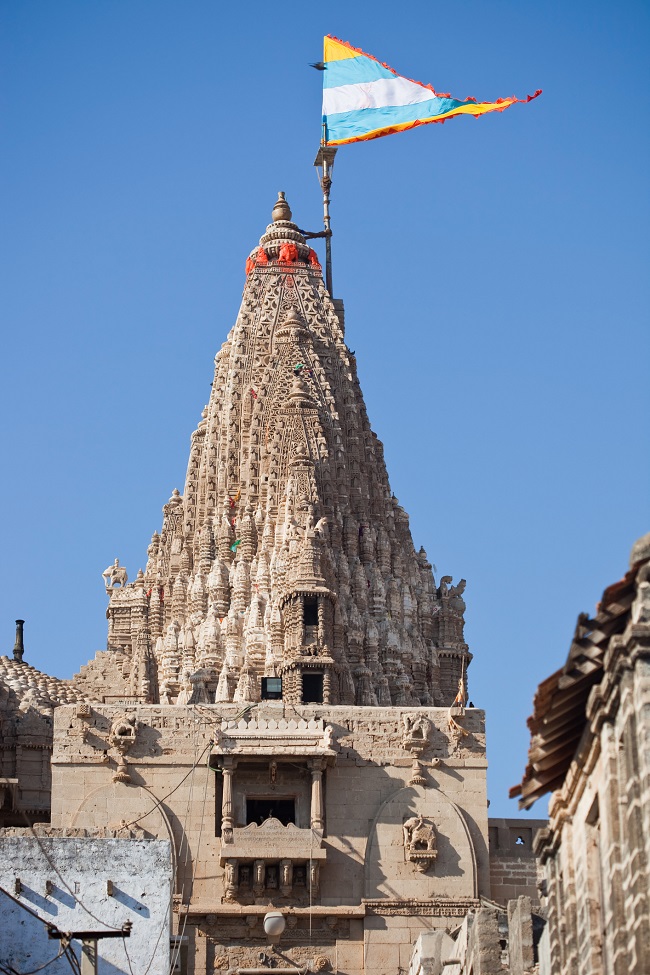
The Dwarka Dham is located in Gujarat state in the Western India at the confluence point of the River Gomti (other than the known tributary of River Ganga of same name) with Arabian Sea. This legendary city was established by Shree Krishna, the original city is believed to have been submerged into sea and the modern day Dwarka was later built in the area. The place is famous for the Dwarkadhish Temple, also known as Jagat Mandir, dedicated to Shree Krishna, who is believed to be 8th incarnation of god Vishnu and worshipped in the name of Dwarkadhish i.e. the King of Dwarka. It became part of Char Dham after Adi Shankara visited the shrine supposedly in the 8th century CE; a memorial of his visit still exists in the precincts of the temple. The main temple is a five-storied structure supported on seventy-two pillars, which rises to a height of seventy-eight metres adorned with a large permanent flag containing symbols of Sun and Moon. The place continues to be a famous destination of the pilgrims of Char Dham. According to popular belief, the original temple was constructed by Krishna’s grandson Vajranabha, though the archaeological findings suggest its life about two millennia old and reconstructed and enlarged around 16th century after the original temple was badly damaged/destroyed by Mahmud Begada of Gujarat Sultanate in 1472 CE.
There are two entrance/exit points to the temple; the main entry door is called the Moksha Dwar (i.e. Door to Salvation") while the exit door is known as the Swarga Dwar (i.e.Gate to Heaven"). The chief deity Dwarkadhish in the sanctum sanctorum is believed to be Trivikrama form of Vishnu depicted with four arms. In the chamber left to the main alter is located the idol of Balrama, the elder brother of Krishna, while the idols of Pradyumna and Aniruddha, son and grandson of Krishna respectively, are located on the right side. In the surrounding area, there are many other shrines dedicated to people associated with Shree Krishna such as Radha, Satyabhama, Jambavati, Lakshmi, Balrama, Sage Durvasa, and Madhav Raoji (another name of Krishna). Besides, two separate temples are also dedicated to Radha – Krishna and Devaki (Krisna’s mother) right in front of the main temple of Dwarkadhish. The city of Dwarka finds a mention in the Epic Mahabharata too as the Dwarka Kingdom and the capital of Shree Krishna which was built by Krishna on a piece of land reclaimed from the sea and several legendary tales are attached to the place.
3. Jagannath Puri Dham
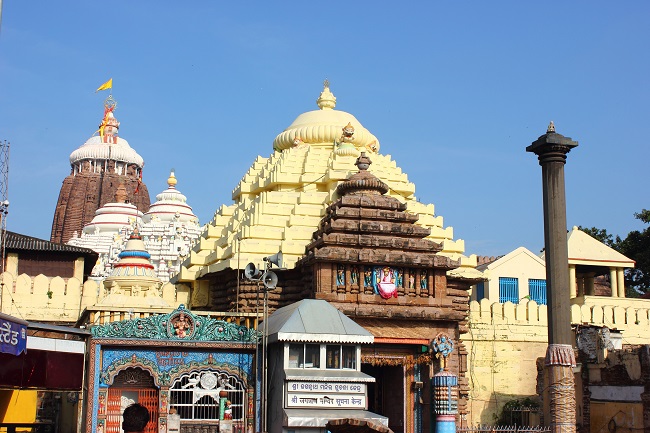
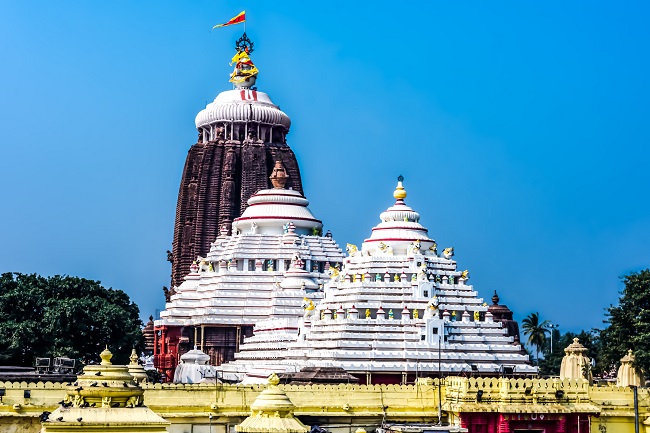
Puri is yet another holy city in the state of Odisha in the Eastern India, which is a seat of Shankaracharya Pitha and Char Dham pilgrimage. The place is remarkable for one of the most important temples of India, the Jagannath Temple, dedicated to Jagannath (Krishna) supposedly an incarnation of god Vishnu. In the annals of history, the Jagannath Temple had been invaded, desecrated and plundered by non-Hindu (mostly Islamists) invaders for eighteen times as part of the religious war (jehad). More recently, under the orders of Mughal Emperor Aurangzeb in 1692 CE, the Nawab of Odisha Ekram Khan had invaded, damaged and plundered it. After the death of Aurangzeb, Muhammad Taqi Khan, Deputy Subedar of Odisha again invaded the Jagannath Temple in 1731 and 1733 CE to desecrate, demolish and plunder its wealth. However, after the destruction/damage caused on each time, the temple was reconstructed/renovated by the efforts of Hindu kings and common people.
The temple is a popular destination of all Hindus but especially auspicious for the adherents of the Vaishnavism Sampradaya. The temple complex has a huge area with a fortified wall and inside the temple complex, there are numerous small shrines of various other deities. Many great saints of the aforesaid tradition such as Adi Shankaracharya, Ramanujacharya, Madhvacharya, Nimbarkacharya, Vallabhacharya and Ramananda have been closely associated with the temple in various ways in the past. Three deities Jagannath, Balbhadra and Subhadra are worshipped at the temple, whose idols carved from the sacred neem logs are installed in the inner sanctum of the temple. The wooden idols of deities are ceremoniously changed every twelve or nineteen years by the exact replicas. These deities are adorned with various attractive clothing and jewelry commensurate with the season. The Puri temple is famous for its annual Rath Yatra (Chariot Festival), during which the three deities are taken out and pulled on huge and decorated temple cars with participation of masses.
4. Rameshwaram Dham
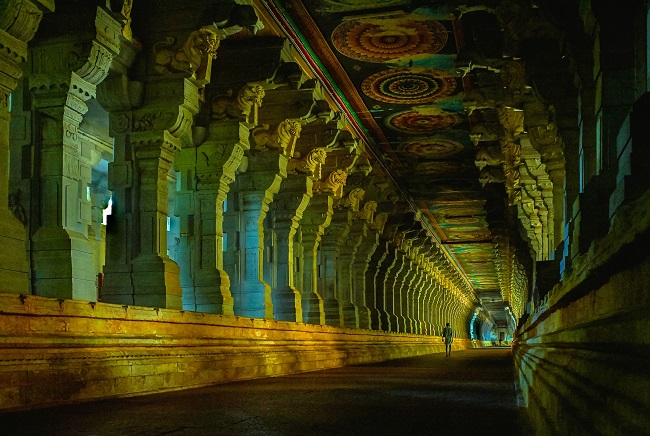
The fourth Dham is located in the southern state of Tamil Nadu on the Rameshwaram Island in the Gulf of Mannar, almost at the tip Indian peninsula. The main shrine Ramanathaswamy Temple is dedicated to god Shiva, which houses one of the twelve Maha Jyotirlingam as the main deity. There are two lingams inside the garbhagriha (sanctum), of which, as per traditional belief, one was built by Sri Ramchandra from the sand as the primary deity and the other one known as Vishwalingam was brought by Hanuman from the Mount Kailash. The temple is built on a huge area with a high compound wall on all sides with tall Gopurams (towers) and remarkably long corridor, bound by huge colonnades on platforms over five feet high. This corridor is considered to be the longest in the world, measuring over twenty-one feet in height, four hundred feet each in the west and east and approximately three hundred fifty feet in the north and south. There are about 1212 pillars in the corridor and the main gopuram (Rajagopuram) is about fifty-three metre tall. Yet another corridor is also formed of sandstone pillars, beams and ceiling inside the temple.
As per the popular legend, the presiding deity (the Lingam) was established and worshipped by Sri Ramchandra in Tretayuga as per Hindu Epoch while crossing the sea over the bridge constructed by his troops during an expedition on Sri Lanka, where the Rakshasa King Ravan had kept Princess Sita in captivity after abduction from the Dandakaranya on the main land. According to Puranas and Epic Ramayana, Sri Ram installed and worshipped the lingam (symbol of Shiva) to get absolved of the sins including Brahmahatya owing to the killing of Ravan (the son of Sage Vishrava). He asked Hanuman to bring lingam from the Himalayas but anticipating delays, a lingam made of sea sand was worshipped and installed by Sri Ram. The ancient temple is very old but more authentic accounts suggest that the kings of Pandya Dynasty had reconstructed and expanded the original temple in the 12th century CE. It was further augmented and refurbished during the 17th century and the Maratha kings ruling Thanjavur contributed for Chatrams (rest houses) in Rameshwaram during the 18th and early 19th centuries. Pilgrimage to Rameshwaram is considered auspicious by the majority Hindu devotees, who believe that the pilgrimage to Kashi (Varanasi) is incomplete without a simultaneous visit to Rameshwaram.
Images (c) istock.com
30-Oct-2022
More by : Dr. Jaipal Singh